-
Paper Information
- Paper Submission
-
Journal Information
- About This Journal
- Editorial Board
- Current Issue
- Archive
- Author Guidelines
- Contact Us
International Journal of Arts
p-ISSN: 2168-4995 e-ISSN: 2168-5002
2018; 8(3): 47-52
doi:10.5923/j.arts.20180803.01

Aesthetic Manifestation of Designs & Ornaments in Islamic Tile-Work Style
Ashraf Bagheripoor
Department of Islamic Art and Humanities, Imam Reza International University, Mashhad, Iran
Correspondence to: Ashraf Bagheripoor, Department of Islamic Art and Humanities, Imam Reza International University, Mashhad, Iran.
| Email: |  |
Copyright © 2018 The Author(s). Published by Scientific & Academic Publishing.
This work is licensed under the Creative Commons Attribution International License (CC BY).
http://creativecommons.org/licenses/by/4.0/

Tile- work is an outstanding element of decoration of Iranian architecture. Unique painting & decoration of tile-work is an origin of splendor and beauty that represents spiritual environment latent secrets in the environment is taken from the artists’ eagerness affected by essential Islamic culture [1]. History shows that in mosque architecture, Designs & Ornaments have a basic role in transferring religious beliefs and mental thoughts, and relates meaning and representation of Iranian-Islamic pure art [2]. The goal of this study is to discover Islamic aesthetic issues in paintings & decoration of mosques which create meaningful and spiritual thoughts [2]. The findings of this investigation shows that mosques, which represents high pitch of secret art and beautification in architecture, are joints of religious thoughts and beliefs with architecture, and drawings and images of tile realize the secret meaning [3]. In the present study, data gathering method is library and documentary, then data analyzed using descriptive –analytic way according to determining evident.
Keywords: Aesthetic, Islamic Aesthetic, Architecture, Tile-work, Mosque, Arabesque designs
Cite this paper: Ashraf Bagheripoor, Aesthetic Manifestation of Designs & Ornaments in Islamic Tile-Work Style, International Journal of Arts, Vol. 8 No. 3, 2018, pp. 47-52. doi: 10.5923/j.arts.20180803.01.
Article Outline
1. Introduction
- Tile-work in Iran is used in decoration of religious places, especially in mosque rather than anywhere [4]. Artists using different colors and various simple geometric designs, which are usually inspired by nature, creates art work, that has a supernatural goal, rather than ordinary aims, but recreate beauty realizing high religious and human needs. As Artour pop wrote, when watching Shikh Lotfallah Mosque (fig 1) in Esfahan: “creation of such art works is just done by believing in God and faith” [4]. Thus manifestation of Islamic aesthetic can be found in Mosques’ Tile- work which is the most important elements of spiritual and meaningful concepts (fig 2 & 3).
 | Figure 1. Shikh Lotfallah Mosque, Iran, Esfahan |
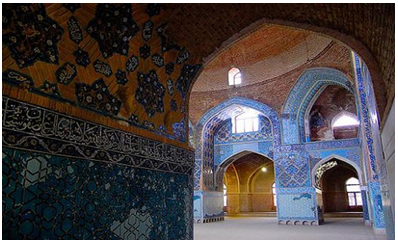 | Figure 2. Kabod mosque, Iran, Tabriz |
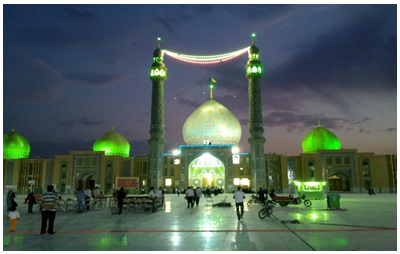 | Figure 3. Jamkaran mosque, Iran, Qom |
2. Methodology
- In the best art works there is a balance between form (physical representation) and content (the spirit of work) [5]. This harmonious nature of the form and content obstacles to reduce art works to their form merely. Value of an art masterpiece is related on such uniqueness of the form and content and discovering harmonious makes an art work a masterpiece. Architecture of Mosques is not excluded from this rule. The functional aspect of tile- work is focused in the present study, and descriptive-analytic method is used to achieve such aim. Both field and library data gathering procedural are used to obtain material of study.
3. Study Limitation
- Because of broad domain of the study, and having Islamic aesthetic various issues in tile-work, we confine ourselves to investigate only Arabesque1 and geometric designs; and to obtain aesthetic principals elicited from such art works.
4. Literature Review
- The Islamic civilization allowed the development of autonomous norms of beauty that were inspired by the faith of Islam. The Islamic artistic tradition viewed the beauty of the universe, emphasized in the Quran, and the literary qualities of the Quranic text itself, as compelling evidence for the divine hand [5].Visual arts in Islam, like other graphical arts, have their own structure and bases which are influenced by many cultural, technical, psychological and geographical factors [6]. Islamic artists create various geometry designs according to the function or location of tile-work. They use such geometric designs as well as divine name and verses (fig 4 & 5). They try to overcome the limitation of sense and to open a new horizon toward ideal perfection and abstraction. To cause a catharsis in visitors [7]. A review on researches conducted in this area seems necessary. Amongst the researches done it tile- work art we may mention:” tile- aesthetic” written by Naser Moqadam Pour (2010) which studied aesthetic bases on tile- art; “Art and Islamic aesthetic” is another investigation written by Fatemah Rahimi (2012) which put forward a comparison of Modern aesthetic vs Islamic aesthetic; another title is “Iran history in Islamic era, architecture decoration” written by Mehdi Maki Nezhad which investigated adornment and decoration in historic and religious places; Moreover we may mention foreign research as “Iranian tiles” written by Stefano Karboni and Tomo Komasaya (2002), and translated by Mahnaz Shayestefar.
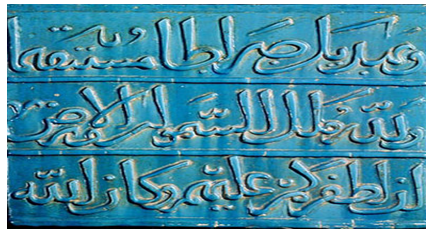 | Figure 4. The verse of Quran2 in Islamic Tile-work Style |
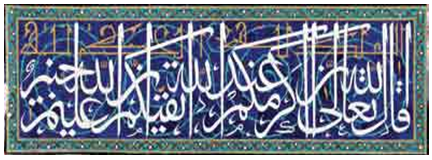 | Figure 5. The verse of Quran3 in Islamic Tile-work Style |
5. Aesthetic
- This term talks about beauty especially in art. Many may consider these two agendas same (1), arguments related to art and aesthetic have a wide history in art philosophy. The aesthetic course has been debated from Socrates era till to two centuries before with various titles, but Boom Garden used aesthetic word for this course in 1735 [8]. There are different views regarding beauty truth. Plato (347-427 B.C) believed that “human being spirit percepts beauty truth in abstraction world” [9], but his student Aristotle stated:” main forms of beauty are symmetry and order, and definition which should be built according to nature rules” [10].Libenitez and his followers like Boom Garten and others believed that beauty perception relates to recognition, they consider sense as beauty perception [8], but Kant analyzed beauty from four points of views: quality, quantity, relativeness and variability [11]. He distinguished that human being acknowledges to the nature besides him and to his existence in nature, the human being seeks for beauty truth in nature besides him. He knew pure beauty including four facets: without interest and profit, without concept, general and aimless end. David Hume stated that for any analysis of beauty we must see inside ourselves rather than essences of things, and to perceive beauty we should do an act more than perception and particular objective characteristics. According to him, the nature has two facets: the first facet is limited world and the second facet is its free and borderless. In the 1st meaning, the limitation of nature consequently results in seeing the ugliness of the world and in 2nd meaning, we see the internal perfection i.e. beauty [11].Hegel (1170-1831) relates beauty to beautiful soul, and art is the manifestation and revelation of this beautiful soul which seeks to education and training. As Hegel stated, God reveal him in two ways. One is in mental way and the other is in objectives way. In other word, God appears in nature and spirit [12]. But from 20th century afterward, a new glance to aesthetic is formed; before that, aesthetic is named as knowledge which extract the rules and principals of aesthetic and realizes and describes characteristics of beauty phenomenon and can be focused on from natural and artistic aspects. From 20th century afterward, aesthetic refers to philosophical studies in beauty realm which gives limitation to the visitors. In such knowledge, a work will be conceived beauty and artistic that awaken an aesthetic experience in the soul spirit of the viewers [12].
6. Islamic Art and Aesthetic
- Aesthetic and understanding of art in modern era has an ontological aspect, i.e. the artist conceives beauty in relation to the whole universe, the essential different of eastern aesthetic and modern aesthetic is the point. Modern aesthetic means in its relation to “the object”. Thus, if in aesthetic studies, we focus on essentiality of “ the object” in western culture and its difference with the philosophy and art in eastern culture, surly, some aspects of Islamic art and the grounds of its aesthetic will be appeared, because modern aesthetic is based on object [13]. This should be compared with Islamic art and beauty in Islam world that is totally mystical and supernatural.In first glance to art in Islam, it seems that a coherent art system is absent, and it may be seen that Moslem artists have followed not special principals and bases in creation of art works and that their art works are imitation of others’ art works.In response to such issue, it should be said that if we take aesthetic in its modern meaning, we have not such Islamic aesthetic, but if we consider beauty in its special meaning in Islam world, we find a kind of mystical approach about beauty which is totally different of modern aesthetic. These foundations and principals are based on art philosophy in Islam- world.In Islamic philosophy history, philosophers like Farabi, Avecina, Sohrevardi, Mola-Sadra,… presented important issues about aesthetic concept. Philosophical agendas of such philosophers are taken from Islamic ontology and anthropology [4]. Peripatetics4 philosophers, consider imagination and thinking as the basic elements of art creation. Other characteristics can be named as Islamic art function in promotion of human perfection and its educational role in art inspiration. According to these philosophers, beauty relates to goodness and virtue, and because God is absolute and the highest virtue, Islamic art works face to the higher mystical world.Enlightenment5 philosophers, regard Islamic on two grounds which are argumentation and enthusiasm. The artist in such philosophy makes a journey inside himself to create a work art to meditate internally and then to conceive the world truth [14]. According to the philosophers, the light which shed on the world truth is taken from Quran verses, from this view, the artist should do divine work, because divine creation is beautiful, thus, the artist who follows it is beautiful.Mola- Sadra, the founder of trancscendent philosophy, conceives art as an attribution and interprets it as, “elegant works”. He stressed on sociological and psychological effects of art. Mola Sadra claims that all pictures and designs of the world are nothing, but God manifestation. Mola Sadra resembles art creation to a melody that is playing. Such musical movement is played because of divine love which is conveyed in all particles of the universe and makes all the world in a harmonious dance. In such aesthetic, the human being is the manifestation of names such as the beautiful, the creator, the painter, and the creator, thus, it can be concluded that God created human in essence and attribution and behaviour like himself. Mola Sadra stressing on human art talent, describes imagination world and believes that imagination and illusions are pillars of Islamic art and aesthetic. We may infer that order, proportional, balance are all key characteristics of Islamic art [15].
7. Foundations of Tile-Work Aesthetic
- The most Important elements in tile-work aesthetic are: space, form, color and design.
7.1. Space
- The first issue of tile-work aesthetic, and generally in Eastern arts, is its deep relationship with supernatural concepts which all are represented in spiritual and meaningful Manifestation [16] (fig 6).
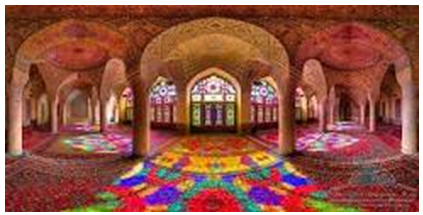 | Figure 6. Space in mosque, Iran, Yazd |
7.2. Form
- Form is the most important aspect of any art. According to such criteria, the form of tile-work is so important. Using tile separately or in combination with other architecture elements gives new appearance to the work [17].
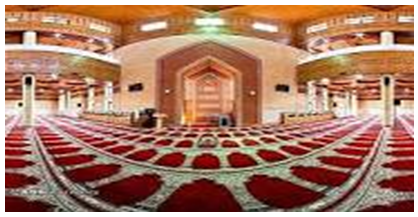 | Figure 7. Space in mosque, Madenh, Sadui Arabia |
7.3. Color
- Color spectrum in Islamic tile-work usually comprises of cold colors with brightness and high distinction to each other. Red and yellow colors are less used, in such tile work [18].Such color spectrum is in absolute distinction with ordinary architecture works using the designs of sky, sea and tree in its live theme enhances this distinction (fig 8).
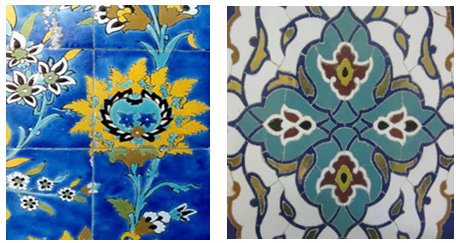 | Figure 8. Color in Islamic Tile-work Style |
7.4. Design
- The most obvious part of tile-work is its design, because of high influence of central and southern parts of Khorasan on Mosque architecture styles, painting of garden, tree, leafs and flower are dominant section of such style (fig 9) [18]. Apart of mental and reflective aspect, such designs are projection of beliefs and religious faith. As an example the painting of sun –like design (Shamseh) in dome ceiling is a representative of sky and sun in its supernatural form (fig 10). Circles with one center is a philosophical symbol of transition of unity to pluralism [19].
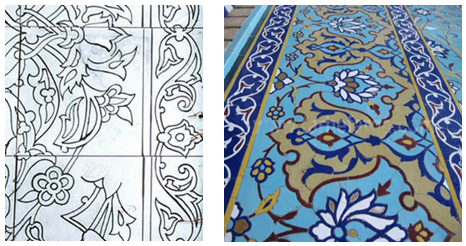 | Figure 9. Leafs and flower design |
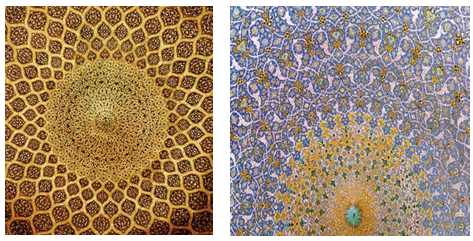 | Figure 10. Sun –like design (Shamseh) in dome |
8. Kinds of Tile Design
- Decorative designs on tile can be categorized as follows:
8.1. Animal-Human Designs
- This kind of design has less prevailing use especially in religious locations and were absent in tile designs tills Qajar era. Birds designs are exceptions here, because they are symbols of paradise and sky [20] (fig 11).
 | Figure 11. Birds Design in Islamic tile-work style |
8.2. Animal-Human Designs & Natural Perspectives
- Animal designs were seen in some tile-works in pre-Islam art (fig 12). But in Islamic era they were absent till Safavi era. The reason of this was influence of western art in Iran. Such designs have less value from art view [20].
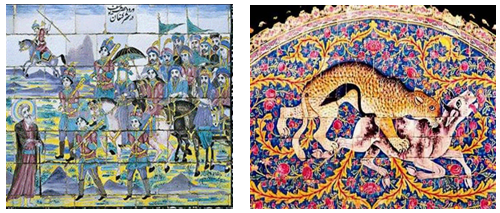 | Figure 12. Animal-Human designs in Islamic tile-work style |
8.3. Geometric Designs
- This kind of design is the oldest type of adornment in tile-work and art in Iran [21]. Simple geometric drawings, curvy lines, semi- circles and… are reminding parts of old time of the art (fig 13). More complicated designs were used in tile art works, which partly because of prohibition of painting of animal-best drawings, in Islam. These designs represent visual art principals such as symmetry, growth, balance and rhythm which its solitariness is an association of the world unity [21].
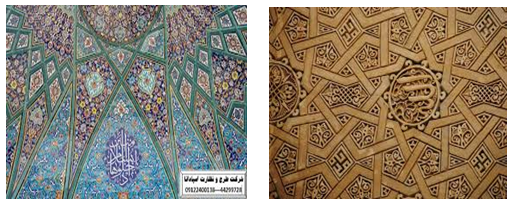 | Figure 13. Geometric designs in Mosque dome |
8.4. Arabesque Designs
- These designs exclusively belong to Islamic- art. Aesthetic manifestations are obvious in such designs. Although the origins of this type of design dated back to pre- Islam era, its real manifestation in art refers to Islamic era (fig 14). Arabesque designs are symbols of cosmic discipline which create illusion and image in the mind of the visitors [22]. They reveal abstraction and supernatural order beyond the real world. Symbols such as these designs are reflection of truth in Islamic art which are presented in secret language. Professor Avani in his article says:“…basically, symbolism is the foundation of creation and God inspiration, sacred art is based on symbolism that means every phenomenon is a cryptograph of a high truth” [23].
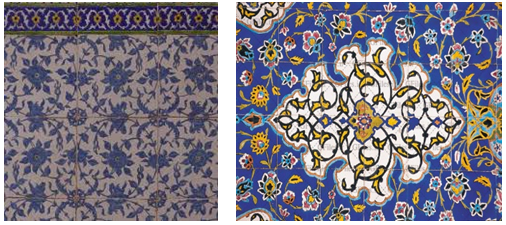 | Figure 14. Arabesque designs |
9. Secret Language and Hermeneutic in Islamic
- In Islamic art, artist use a cryptographic and secret language to talk about sacred truth. Islamic art works use a mystery covert meaning which points to a higher, divine truth. Such code artistic language was used to conceal the gem of truth from whom, recommended to be kept far from such gem [24]. Amongst cryptographic elements in Islamic art, especially in architecture geometric paintings and drawings may be mentioned. Thus, tile work drawings may be categorized according to their functions into “horizon drawings” and “meaningful drawing”. Drawing based on human sense are horizon geometry, on the other side, drawings, based on human intuition are meaningful geometry. Horizon geometry is sub part of meaningful geometry. Deep meaning and wonderful beauty of meaningful geometry cause everybody to confess that such art is just inspired by God. Akhvan Safa completely discussed such issue [25].
10. Principals and Grounds of Islamic Aesthetic in Geometric & Arabesque Drawings of Tile-work
- As mentioned previously, geometric and arabesque designs are totally taken from Islamic ontology and philosophical aesthetic bases. Such designs are associations of enlightenment philosophy with its complicated lines and images manifestation of divine truth is totally revealed in drawings of tile-work which put forward visual glory toward seeing the world. Arabesque and geometry designs suggest the concept of bounty existence in Islamic ontology philosophically. According to this harmonious mystical theme, the whole university is a bounty existence of a God. Such drawing seen indefinitely because of their repetition, like sun which dispatches its rays, God creates all the world. Looking through a hermeneutic eye, all flowers and flora of tile-work arabesque drawing delineate heaven and high world. They create visual beauty for visitors and cause them watch their internal beauty in abstraction.
11. Conclusions
- Investigating arabesque and geometry designs in tile-work of mosques results in eliciting themes like simplicity, balance, harmony, virtue, mystical attitude and such and so. Moreover, to understand value and beauty of the universe, piety and virtue have been considered in Islamic aesthetic school. This approach truly advices artists to achieve overall aesthetic paradigms by investigating the world phenomena through a mystical and divine glasses. Tile work aesthetic bases, as mentioned in the body of our study, tries to investigate issues like space, form, color and so on, which their function is to illustrate a spiritual and supernatural spirit in mosques. The present study shows that Islamic-mystical spirituality is portraying a new mental experience in the visitors, by using geometry elements such as lines, curves, adornments, designs, colors and etc. This means that Islamic architecture and art has the potentiality to invite visitors to a sacred and secret world of meaning. According this paradigm all arts, particularly tile-work and inscriptions have same origin and goal. Art is able to reflect meaningful sacred world to human being; and transfers him to supernatural world of truth to discover concepts such as bounty existence, singleness vs pluralism, God unity, promised paradise. Perception of this kind of beauty provide the ground to achieve to absolute truth and beauty.
12. Footnote
- 1) beauty realm is much wider than art realm. Art is perceived to human- made works. Although beauty is a significant element of art works, beauty can’t be confined to artistic works. Beauty may be defined for natural phenomenal, rather than art works. From what has been said so far, it is obvious that the domain of aesthetic is much extended than art domain. John Haspers said in his article discussing of art and aesthetic definition: ‘aesthetic is a branch of philosophy which discusses aesthetic issues through concepts’ analysis. Aesthetic themes include all items that can be experienced aesthetically. For more information refer to: Bendeto kroche, aesthetic complete work, translated by Foad Rohani, cultural and scientific press, Tehran, 1988, p.53.
Notes
- 1 - the most famous design in Islamic art.2 - That Allah… and guide thee on the Straight Way; (48/2).3 - …Verily the most honored of you in the sight of Allah is (he who is) the most righteous of you. And Allah has full knowledge and is well acquainted (with all things). (49/ 13) 4 - followers of philosophy of Aristotle in Islamic societies. 5 - followers of philosophy of Sohravardi in Islamic societies.
 Abstract
Abstract Reference
Reference Full-Text PDF
Full-Text PDF Full-text HTML
Full-text HTML